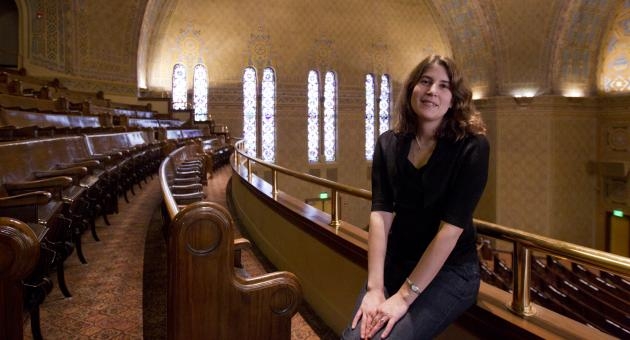Collaboration enriches professor’s exploration of the American Jewish experience

Lila Corwin Berman always has her eyes on bridges, both constructing and deconstructing them. But she's not an engineer — she's an historian.
As the new director of Temple's Feinstein Center for American Jewish History, Berman explores the bridges between academics and practitioners, the past and present, history and politics, religion and identity, and the city and suburbs.
"At the center, we strive to make academic work meaningful by not only serving the scholarly community but also engaging with the public," said Berman.
Founded in 1990, the Feinstein Center brings together scholars and lay people interested in the American Jewish experience. To that end, the center collaborates regularly with external institutions, such as the Gershman Y and the National Museum of Jewish American History. It also sponsors conferences, fellowships and public events all devoted to new approaches to understanding the many dimensions of Jewish experience in the United States.
From early on, Berman's work has been about making connections. As an undergraduate at Amherst College she studied lots of different religions, she says, but ended up writing a senior thesis on newly-religious Jewish women who moved from the United States to Israel as they became increasingly observant.
That project got her thinking about religion as a social force that structured relationships of power: between men and women, parents and children, the state and citizens, and others.
"By the time I entered graduate school at Yale, I knew I wanted to study American Jewish identity from a historical perspective, as a way of bridging religion, politics, and questions about identity," said Berman.
Today, Berman continues that line of scholarly inquiry. Her first book, Speaking of Jews: Rabbis, Intellectuals, and the Creation of an American Public Identity (University of California Press, 2009), examines Jews’ efforts to connect with and explain themselves to non-Jews from the 1920s through the 1960s. "Through these efforts, they redefined what it meant to be Jewish in twentieth-century America and remade Jewishness as an ethnicity." she said.
Berman is currently at work on a book, tentatively called Jewish Urban Journeys Through an American City and Beyond, that traces Jews’ migration away from urban America in the postwar years. The book focuses in particular on Detroit and the ways that Jews remade their racial politics, communal identities and spiritual lives as they left the city. For her work in this area, she was recently awarded a fellowship from the American Council of Learned Societies.
Arriving at Temple just three years ago from Penn State, Berman spent her first year getting acclimated, but an upcoming symposium titled "The Art of Being Jewish in the City: Aesthetics, Politics and Power" will be the grand finale of a full two years of conferences, events and even a performance focused on Jews and urbanism.
"Temple's Department of History is an ideal place to locate this type of exploration," said Berman. "It is full of top-notch urban historians, and a lot of forces in the department intersect around urban questions."
According to Berman, as Jews were leaving American cities during the post-war period, they were also grappling with being middle class and suburban, and there was a part of them that was staying behind.
"Many of them never left cities in their minds," she said.
"Through these two-years of programming and upcoming conference, we are asking, 'How did Jews retain their investment in cities both as part of their identity but also materially, politically and economically?'"